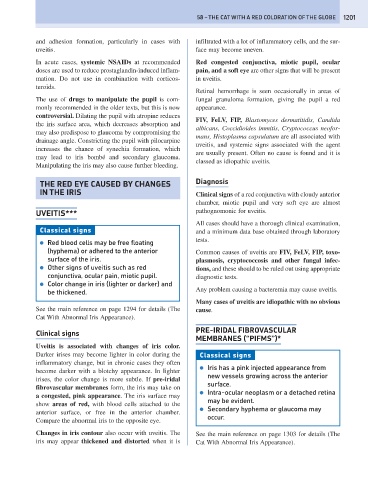Page 1209 - Problem-Based Feline Medicine
P. 1209
58 – THE CAT WITH A RED COLORATION OF THE GLOBE 1201
and adhesion formation, particularly in cases with infiltrated with a lot of inflammatory cells, and the sur-
uveitis. face may become uneven.
In acute cases, systemic NSAIDs at recommended Red congested conjunctiva, miotic pupil, ocular
doses are used to reduce prostaglandin-induced inflam- pain, and a soft eye are other signs that will be present
mation. Do not use in combination with corticos- in uveitis.
teroids.
Retinal hemorrhage is seen occasionally in areas of
The use of drugs to manipulate the pupil is com- fungal granuloma formation, giving the pupil a red
monly recommended in the older texts, but this is now appearance.
controversial. Dilating the pupil with atropine reduces
FIV, FeLV, FIP, Blastomyces dermatitidis, Candida
the iris surface area, which decreases absorption and
albicans, Coccidioides immitis, Cryptococcus neofor-
may also predispose to glaucoma by compromising the
mans, Histoplasma capsulatum are all associated with
drainage angle. Constricting the pupil with pilocarpine
uveitis, and systemic signs associated with the agent
increases the chance of synechia formation, which
are usually present. Often no cause is found and it is
may lead to iris bombé and secondary glaucoma.
classed as idiopathic uveitis.
Manipulating the iris may also cause further bleeding.
THE RED EYE CAUSED BY CHANGES Diagnosis
IN THE IRIS Clinical signs of a red conjunctiva with cloudy anterior
chamber, miotic pupil and very soft eye are almost
UVEITIS*** pathognomonic for uveitis.
All cases should have a thorough clinical examination,
Classical signs and a minimum data base obtained through laboratory
● Red blood cells may be free floating tests.
(hyphema) or adhered to the anterior Common causes of uveitis are FIV, FeLV, FIP, toxo-
surface of the iris. plasmosis, cryptococcosis and other fungal infec-
● Other signs of uveitis such as red tions, and these should to be ruled out using appropriate
conjunctiva, ocular pain, miotic pupil. diagnostic tests.
● Color change in iris (lighter or darker) and
be thickened. Any problem causing a bacteremia may cause uveitis.
Many cases of uveitis are idiopathic with no obvious
See the main reference on page 1294 for details (The cause.
Cat With Abnormal Iris Appearance).
PRE-IRIDAL FIBROVASCULAR
Clinical signs
MEMBRANES (“PIFMS”)*
Uveitis is associated with changes of iris color.
Darker irises may become lighter in color during the Classical signs
inflammatory change, but in chronic cases they often
● Iris has a pink injected appearance from
become darker with a blotchy appearance. In lighter
new vessels growing across the anterior
irises, the color change is more subtle. If pre-iridal
surface.
fibrovascular membranes form, the iris may take on
● Intra-ocular neoplasm or a detached retina
a congested, pink appearance. The iris surface may
may be evident.
show areas of red, with blood cells attached to the
● Secondary hyphema or glaucoma may
anterior surface, or free in the anterior chamber.
occur.
Compare the abnormal iris to the opposite eye.
Changes in iris contour also occur with uveitis. The See the main reference on page 1303 for details (The
iris may appear thickened and distorted when it is Cat With Abnormal Iris Appearance).

